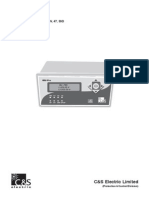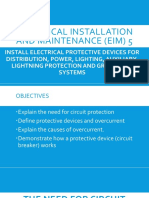Vax21 31 Mvaxm Commisionin G
Vax21 31 Mvaxm Commisionin G
Uploaded by
Sumit VermaCopyright:
Available Formats
Vax21 31 Mvaxm Commisionin G
Vax21 31 Mvaxm Commisionin G
Uploaded by
Sumit VermaOriginal Description:
Original Title
Copyright
Available Formats
Share this document
Did you find this document useful?
Is this content inappropriate?
Copyright:
Available Formats
Vax21 31 Mvaxm Commisionin G
Vax21 31 Mvaxm Commisionin G
Uploaded by
Sumit VermaCopyright:
Available Formats
FOR VAX21/31/MVAXM12/31
VAX/MVAXM COMMISSIONING INSTRUCTION Page
of
TRIP CIRCUIT SUPERVISION RELAY TYPE VAX21/31/MVAXM21/31
COMMISSIONING INSTRUCTION
CONTENTS
1. 2. 3. 4. 4.1 4.2 4.3 4.4 5. INTRODUCTION GENERAL DESCRIPTION SPECIFICATION COMMISIONING GENERAL INSPECTION WIRING CHECK RELAY TESTING ALARM CIRCUITS CHECK ILLUSTRATIONS Figure 1a Supervision circuits with type VAX21 relay Figure 1b Supervision circuits with type MVAXM21 relay Figure 2a Supervision circuits with type VAX31 relay Figure 2b Supervision circuits with type MVAXM31 relay
VAX/MVAXM COMMISSIONING INSTRUCTION Page
of
1. INTRODUCTION This manual covers the commissioning and maintenance instructions for Trip Circuit Supervision Relay Types VAX&MVAXM Type VAX/MVAXM relays are used for continuous supervision of the trip circuit of circuit breakers. 2. GENERAL DESCRIPTION: Type VAX and MVAXM relays are of simple and robust construction. They are arranged to initiate an audible alarm and visual indication if the trip circuit of a circuit breaker fails or the breaker tripping mechanism does not operate . Two versions of type VAX and MVAXM relays are available. Type VAX 21 and MVAXM 21 relays monitor the trip circuit only when the circuit breaker is closed (post-closing supervision only) while type VAX 31 and MVAXM 31 relays monitor the trip circuit continuously (both preclosing and post-closing supervision). Both versions detect the following conditions. 1)Failure of trip supply 2)Open circuit of trip coil or trip circuit wiring 3)Failure of mechanism to complete the tripping operation Type VAX 21 and MVAXM 21relays consist of two units connected as shown in figures 1(a) and 1(b). Under healthy conditions with the circuit breaker closed, both units are energised. If the trip circuit gets open or the trip supply fails, unit A drops-off and opens contact A-1 to de-energise unit C. When the circuit breaker is open the auxiliary switch of the circuit breaker shorts contact A-1 to hold-in unit C. Type VAX 31 and MVAXM 31 relays consist of three units connected as shown in figures 2(a) and 2(b).Under healthy conditions with the circuit breaker closed, units A and C are energised and the operation is the same as that of type VAX 21 and MVAXM 21 relays. When the circuit breaker is open unit B is also energised via the normally closed auxiliary switch of the circuit breaker and unit C is held-in by contact B-1.Unit B will detect trip circuit abnormalities with the circuit breaker open in a similar manner as unit A with the circuit breaker closed. The C unit in both the versions are delayed on drop-off by means of RC circuit for a total time of 350 to 800 milli seconds, to prevent a false alarm due to voltage dips caused by faults in other circuits or during a normal tripping operation, when unit A is momentarily short circuited by the self reset tripping relay contact, If the trip relay fails to reset possibly due to failure of the circuit breaker tripping mechanism, the alarm is initiated. The alarm unit is designed to operate via pilot wires, if required. 3. SPECIFICATION TECHNICAL DATA
VAX/MVAXM COMMISSIONING INSTRUCTION Page
of
Coil ratings For VAX relay: 24,30,48,50,110/125 or 220/250 volts dc operating band 80%-120% of rated voltages. Maximum loop resistance 50 ohms for nominal alarm supply 24 to 50V. Other alarm supplies - 400 ohms. When rated for a 110V alarm supply the unit C will not operate at a current less than 25 milliamperes. It is therefore suitable for use with anticorrosion negative potential biasing device. For MVAXM relay: 110/125 and 220/250 volts dc as standard and other coil ratings are available on request. Maximum loop resistance is 400 ohms for nominal alarm supply.
Operating Time
0.35 to 0.8 sec. At 80% of rated volts ( between failure of the trip circuit and operation of alarm contact).
Thermal rating
120% of rated voltage continuous. 4.0 COMMISSIONING 4.1 General Inspection: Wipe away any dust that has collected on the outside of the relay before opening the cover. Make a general inspection of the relay to ensure that any moving parts if fitted are free to move and that there are no signs of damage anywhere. Check that there are no loose connections or terminals and that the equipment is clean and free from dust. 4.2 Wiring Check : Make a through check of the internal and external wiring of the relay. The internal wiring can be checked by reference to the relay-wiring diagram, The external wiring should be checked with the help of schematic diagrams (Showing reference number of interconnecting wires, relay terminal nos. etc.) supplied by the relay panel manufacturers. 4.3 Relay Testing : Apply the Dc voltage for coil A/B and increase the DC voltage till Unit A/B operates and record the value (Operating value =30% - 80% of rated auxiliary voltage) .Apply the DC voltage for coil C with Unit A/B operated condition and increase the DC voltage till Unit C operates and record the value (operating value 60% - 90% of rated auxiliary voltage). If variable DC voltage source is not available at site then confirm the scheme operation only. 4.4 Alarm Circuit Checks: It is essential that on completion of the above tests, alarm circuits are to be checked with the scheme.
VAX/MVAXM COMMISSIONING INSTRUCTION Page
of
5.0 ILLUSTRATIONS Figure 1a Supervision circuits with type VAX21 relay Figure 1b Supervision circuits with type MVAXM21 relay Figure 2a Supervision circuits with type VAX31 relay Figure 2b Supervision circuits with type MVAXM31 relay
VAX/MVAXM COMMISSIONING INSTRUCTION Page
of
You might also like
- Electrical System For High Rise BuildingDocument47 pagesElectrical System For High Rise BuildingMohammad Belal Hossain87% (31)
- The Technology of Instrument Transformers: Current and Voltage Measurement and Insulation SystemsFrom EverandThe Technology of Instrument Transformers: Current and Voltage Measurement and Insulation SystemsNo ratings yet
- Enclosure 6150 Derscription PDFDocument85 pagesEnclosure 6150 Derscription PDFCeleste Maradiaga50% (2)
- Mvaa Techdata enDocument5 pagesMvaa Techdata enAdip ChyNo ratings yet
- Vaj CortecDocument6 pagesVaj CortecHari Krishna.MNo ratings yet
- Ashida 2010 Compact CatalogueDocument4 pagesAshida 2010 Compact Catalogueqaisar_shafi100% (1)
- 1030365248421-Mvap en 0899Document4 pages1030365248421-Mvap en 0899Stone123456789No ratings yet
- Trip Circuit and Trip Coil Supervision Relay: - Type VAXDocument5 pagesTrip Circuit and Trip Coil Supervision Relay: - Type VAXShara Maica Salvador50% (2)
- Type VHXM: Under / Over Voltage RelayDocument6 pagesType VHXM: Under / Over Voltage RelayNikki AgarwalNo ratings yet
- O&m - Manual - 220V - 187 Ah Plante Battery PDFDocument16 pagesO&m - Manual - 220V - 187 Ah Plante Battery PDFrukmagoud100% (1)
- CBC Series ChargerDocument2 pagesCBC Series ChargerJohan TravelNo ratings yet
- Vapm 31Document4 pagesVapm 31AONLA100% (1)
- p345 Technical ManualDocument1 pagep345 Technical ManualabhayambujNo ratings yet
- Technical Proposal For Setting Up A Model Substation For TrainingDocument14 pagesTechnical Proposal For Setting Up A Model Substation For Trainingjigyesh sharmaNo ratings yet
- Catalogue For TFM-FR-TZ-TX-B PDFDocument15 pagesCatalogue For TFM-FR-TZ-TX-B PDFGuru Vaga50% (2)
- mc61c PDFDocument32 pagesmc61c PDFashishchugh44No ratings yet
- Type CAEM 21 Battery Earth Fault RelayDocument5 pagesType CAEM 21 Battery Earth Fault RelayVikas OzaNo ratings yet
- Trip Circuit Supervision Relay TestDocument2 pagesTrip Circuit Supervision Relay TestJayaprakash M PNo ratings yet
- Auxiliary RelayDocument5 pagesAuxiliary RelayVijayaganthaan VisvanatthanNo ratings yet
- VTXDocument6 pagesVTXHari Krishna.MNo ratings yet
- Dokumen - Tips - Numerical Rho 3 Motor Protection Relay Easun R Current TransformerDocument4 pagesDokumen - Tips - Numerical Rho 3 Motor Protection Relay Easun R Current TransformerPAWAN RAJPUTNo ratings yet
- Trivector MeterDocument2 pagesTrivector MeterTarun AhujaNo ratings yet
- RXTCS Brochure PDFDocument6 pagesRXTCS Brochure PDFUdit OjhaNo ratings yet
- Type P8n, PQ8n, PN8n: Auxiliary RelayDocument7 pagesType P8n, PQ8n, PN8n: Auxiliary RelayDinesh ThevanNo ratings yet
- Relay TerminalsDocument3 pagesRelay Terminalssundars_sriNo ratings yet
- Generator ProtectionDocument72 pagesGenerator ProtectionJennifer SimpsonNo ratings yet
- MRA1 - Trip Circuit Supervision: Manual MRA1 (Revision A)Document20 pagesMRA1 - Trip Circuit Supervision: Manual MRA1 (Revision A)Andrea MaurillaNo ratings yet
- Iru ProDocument18 pagesIru ProjaikolangaraparambilNo ratings yet
- Spaj140c1 PDFDocument29 pagesSpaj140c1 PDFRihlesh ParlNo ratings yet
- Autochangeover in Power PlantsDocument18 pagesAutochangeover in Power PlantsSukant BhattacharyaNo ratings yet
- Operating Instructions NewDocument54 pagesOperating Instructions NewSuja PulparambathNo ratings yet
- Reverse Blocking For BusbarDocument2 pagesReverse Blocking For BusbarsamlashNo ratings yet
- Mahadiscom Dry TypeDocument22 pagesMahadiscom Dry TypeSANJAY BHATTACHARYANo ratings yet
- HT Capacitor Bank and Reactor Test and CommissioningDocument2 pagesHT Capacitor Bank and Reactor Test and CommissioningAodman4u0% (1)
- NIFPS CatalougeDocument5 pagesNIFPS CatalougesheshidharrajubNo ratings yet
- REF - NO.PSE/P 2603-2 List: HBL Power Systems LTDDocument22 pagesREF - NO.PSE/P 2603-2 List: HBL Power Systems LTDmukesh_kht1No ratings yet
- BAPCON-Sigma RTUSigma O&M Manual Draft 2Document37 pagesBAPCON-Sigma RTUSigma O&M Manual Draft 2Suman GhoshNo ratings yet
- 41-P-135 (Earthing Platform)Document6 pages41-P-135 (Earthing Platform)RamzanNo ratings yet
- Switch CatDocument104 pagesSwitch CatAnonymous SDeSP1No ratings yet
- Inductance of 3 Phase LineDocument50 pagesInductance of 3 Phase LineFemi PrinceNo ratings yet
- Common Problems Observed and Its RemedyDocument6 pagesCommon Problems Observed and Its RemedyMayank KumarNo ratings yet
- Loop Impedance - B1Document5 pagesLoop Impedance - B1madhavanNo ratings yet
- NGR PanelDocument17 pagesNGR PanelnikerNo ratings yet
- Fast Bus Transfer Systems: A System Solution Approach: Aartech Solonics LTD., Bhopal, IndiaDocument38 pagesFast Bus Transfer Systems: A System Solution Approach: Aartech Solonics LTD., Bhopal, IndiaDurga PrasadNo ratings yet
- Siemens Power Engineering Guide 7E 327Document1 pageSiemens Power Engineering Guide 7E 327mydearteacherNo ratings yet
- A Review On Various Transformer Testing SystemsDocument4 pagesA Review On Various Transformer Testing Systemsijsret100% (1)
- SPC 324A 14 Asbuilt DGRDocument4 pagesSPC 324A 14 Asbuilt DGRapsNo ratings yet
- TRE - 72064N - TIS Rev-01Document18 pagesTRE - 72064N - TIS Rev-01ankushbahaleNo ratings yet
- SF6 GCB and IsolatorsDocument4 pagesSF6 GCB and IsolatorsPritam SinghNo ratings yet
- ElectricalDocument14 pagesElectricalbharat_ravulapalliNo ratings yet
- ABB Substation Condition Monitoring ScheduleDocument16 pagesABB Substation Condition Monitoring Schedulelbk50No ratings yet
- Fuse Contactor Selection - 6.6kVDocument10 pagesFuse Contactor Selection - 6.6kVapmanungadeNo ratings yet
- Instrument Safety Factor of Current TransformerDocument16 pagesInstrument Safety Factor of Current TransformerEngr saqibNo ratings yet
- Tech. Specifications On Power TransformerDocument2 pagesTech. Specifications On Power Transformershine1975No ratings yet
- Marshalling Box Is A Type of Box Which Is Connected at One Side of Transformer. ItDocument1 pageMarshalling Box Is A Type of Box Which Is Connected at One Side of Transformer. ItvigneshwarannnNo ratings yet
- Digital Automatic Voltage Regulator Operation and Maintenance ManualDocument454 pagesDigital Automatic Voltage Regulator Operation and Maintenance ManualNaresh Pattanaik100% (1)
- Relay Test Reports - CRP-6071 - 1Document15 pagesRelay Test Reports - CRP-6071 - 1rajesh kannanNo ratings yet
- Raica: Breaker-Failure ProtectionDocument8 pagesRaica: Breaker-Failure ProtectionsrinivasgateNo ratings yet
- Positive, Zero, Negative Sequence of AlternatorDocument3 pagesPositive, Zero, Negative Sequence of AlternatorJeya Kannan100% (1)
- Indoor Surge Arresters-Model - SPFDocument3 pagesIndoor Surge Arresters-Model - SPFSOUMENNo ratings yet
- MM-30 RelayDocument32 pagesMM-30 RelaySomnathNo ratings yet
- Vax 31Document6 pagesVax 31ishak789No ratings yet
- High Voltage Circuit Breakers Design and ApplicationsDocument382 pagesHigh Voltage Circuit Breakers Design and ApplicationsA Hasib ChowdhuryNo ratings yet
- Acti9 Tripping Curves & Short-Circuit Current LimitingDocument14 pagesActi9 Tripping Curves & Short-Circuit Current LimitingFred Jayson Palisoc CabansagNo ratings yet
- MiCOM Alstom P54x Ver47 - 57K Addendum GBDocument186 pagesMiCOM Alstom P54x Ver47 - 57K Addendum GBSukant BhattacharyaNo ratings yet
- APC Silcon 60 80kW 208 480V User Guide PDFDocument34 pagesAPC Silcon 60 80kW 208 480V User Guide PDFft1ft1No ratings yet
- ELSPS01DDocument4 pagesELSPS01DslawclumehbgohigduNo ratings yet
- SSF20B220 Product DetailsDocument1 pageSSF20B220 Product DetailsJosue Crespo GonzalezNo ratings yet
- Technical Guidance For Customer Export Limiting SchemesDocument34 pagesTechnical Guidance For Customer Export Limiting SchemesDavid GarciaNo ratings yet
- Impact - of - Grading - Capacitor - On - Transient Recovery Voltage During Switching Out of Shunt ReactorDocument8 pagesImpact - of - Grading - Capacitor - On - Transient Recovery Voltage During Switching Out of Shunt Reactorchandraippa2No ratings yet
- ComPact NSXM - LV426215Document3 pagesComPact NSXM - LV426215mohammed hassan abdulaleemNo ratings yet
- 7SJ64 13.8kV Busbar ProtectionDocument2 pages7SJ64 13.8kV Busbar ProtectionBalajiNo ratings yet
- CHAPTER 10 - High Voltage TestingDocument21 pagesCHAPTER 10 - High Voltage TestingNur Hidayah Yusof LatifNo ratings yet
- Section 11: Switchboards and SwitchgearDocument38 pagesSection 11: Switchboards and SwitchgearPiero Garcia VerdoniNo ratings yet
- Midos Types LFAA 101, 102 Auto-Reclose RelayDocument10 pagesMidos Types LFAA 101, 102 Auto-Reclose Relaykribo asus100% (1)
- Distribution Line Performance and Reliability Improvement Through Feeder Reconfiguration in Dessie TownDocument53 pagesDistribution Line Performance and Reliability Improvement Through Feeder Reconfiguration in Dessie TownAnonymous fxCgVPgNo ratings yet
- Strings, Parallel Cells, and Parallel StringsDocument17 pagesStrings, Parallel Cells, and Parallel StringsJohn DoeNo ratings yet
- Mod. PDG-2/EV: Demonstration Panel For The Electric Testing Carried Out in Industrial BuildingsDocument2 pagesMod. PDG-2/EV: Demonstration Panel For The Electric Testing Carried Out in Industrial BuildingsderbalijalelNo ratings yet
- Fresh Water Fire Pump - NP-FWF-MDB-0001Document15 pagesFresh Water Fire Pump - NP-FWF-MDB-0001SARAVANAN ANo ratings yet
- Dsp-Ohmni: C-EG30EM Instruction Manual V2, June 2020Document50 pagesDsp-Ohmni: C-EG30EM Instruction Manual V2, June 2020Carlos CamayoNo ratings yet
- ANSI Device NumbersDocument3 pagesANSI Device NumbersMasrurul Azni Abdul AzizNo ratings yet
- 3 Pole ATS White PaperDocument6 pages3 Pole ATS White PaperluisNo ratings yet
- EIM 5 Lesson 1Document25 pagesEIM 5 Lesson 1Victor Rosales50% (2)
- IM04302004E - Freedom 2100 Motor Control Center Installation and Maintenance ManualDocument32 pagesIM04302004E - Freedom 2100 Motor Control Center Installation and Maintenance ManualErikson DamianNo ratings yet
- Busway Short Ciruit Testing ProceduresDocument3 pagesBusway Short Ciruit Testing ProceduresJAIRO EDUARDO RAMIREZ ACERO100% (1)
- Ma8045 Ma Eu enDocument70 pagesMa8045 Ma Eu enMauricioNo ratings yet
- Whitepaper Switching of Filter Circuits With Vacuum SwitchesDocument8 pagesWhitepaper Switching of Filter Circuits With Vacuum Switchesvijayeee82No ratings yet
- Type 2 Co-Ordination ExplainedDocument4 pagesType 2 Co-Ordination ExplainedSteve BouckleyNo ratings yet
- System Pro M Compact: and Other Modular Devices For Low Voltage InstallationDocument513 pagesSystem Pro M Compact: and Other Modular Devices For Low Voltage Installationmercury7k29750No ratings yet
- Siemenspti Software Psse Brochure 2017Document8 pagesSiemenspti Software Psse Brochure 2017sajuaanalsaNo ratings yet

























































































